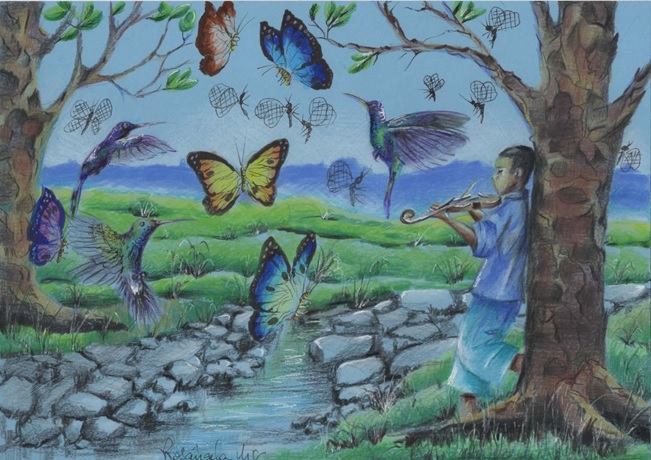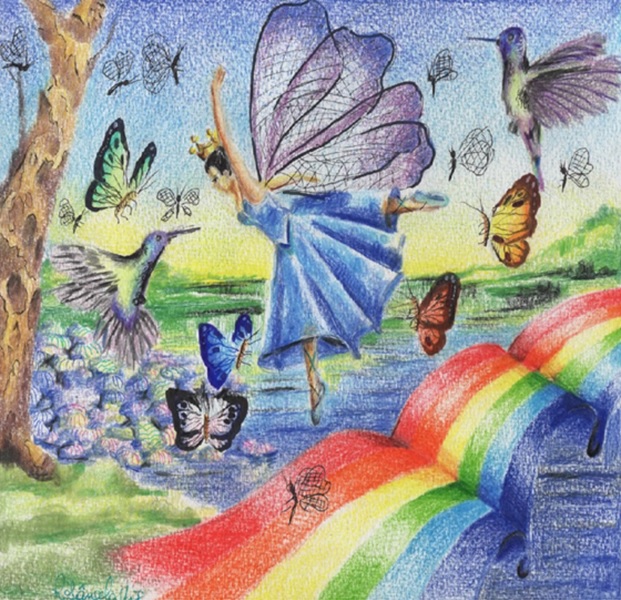
Renew yourself.
Reborn in yourself,
Multiply your eyes to see more.
Multiply your arms to sow everything.
Always be the same.
always the other.
But always loud.
Always far away.
And inside everything.
(MEIRELES, 1995, Canticle XIII)
The limit that the dream imposes is the height of a flight that the soul reaches; is looking lost at the horizon in search of the nuances of the sky; is the rest of a pencil on white paper, while thought wanders free in the empty space of the mind in daydreams. And it could be that the legends, the fables, the tales appear exactly at this moment when, so beautiful, the fantasy even seems like chimera. A utopian vision from the inside of the spirit, in a moment of deep digression. There are no limits to the enchanted gaze when the horizon is wide and opens its arms to the journey that starts from then on.. Thus is born the process of creation, thus born an artwork.
artistic creation is, for this ability that has the hands to weave what the boiling mind proposes that, each one is given in a different way.. the filing, the perceptions and even the absorption of knowledge are made in the way of each one, uniquely. About this,
What has always fascinated me about human behavior is that there is no such thing as generalizing, we are unique, each one with its own personality and each one reacts in a way to the same situations. It's always a box of surprises. (VIEIRA, 2020, p.89)
The look inside the soul allows the journey through the playful fields to be unique, if the mind allows it and lets go. And if there are no copies in real life, there are no copies in Art, nor is an artist capable of copying his own work. At the time of creation his spirit traveled along paths that will never be repeated in his life. And the interior of the soul is full of enchantments when you wallow in the most forgotten recesses and depths. everything is ready, just search carefully.
Thus was born the dancer and the indigo boy in his Awakening to the Golden Age. The proposal of the writer and therapist Cenira de Fátima Vieira, arrived with the theme of his book “The Awakening of Indigo Consciousness in the Golden Age”.
Sometimes it is necessary for the artist to record names of elements that come to mind, make them sketches or scribbles, so that the train of thought is not lost. like a photograph, the look gradually captures elements and sets up the scene, like a game of fitting pieces. And the blank paper or canvas are the boards of this game that is gradually being composed.
Plunging into the depths of the core, the elements were jumping little by little, in the form of birds, of butterflies, of fish, of dragonflies and a lot of nature around. All this joined the blue color, Lilac, golden; and to the movement, as if the narrative were taking place at the moment the gaze rests on it.
Joining such elements, the next step is assembling the scene, leaving few empty spaces, not too much information; proper distribution of colors; and a finely tuned look at the vanishing point and perspective. The price will be magic, there may still be changes, since it's a surreal and fantastic world.
Then came the solitary violinist (Fig. 1), attracting the world of butterflies to you, as if he joins two worlds before him. And right after the Ballerina, that possibly inhabits this golden world with its giant butterflies and birds. To cross this fine line that limits the two worlds, it is necessary to wander through a beautiful rainbow bridge that moves eternally. in delicate posture, dancing, she crosses this path on a back and forth, back and forth, until he finds the violinist and the two, together, evolve into a golden world and much better. with them, the elements of the scene are distributed, without one overlapping the other, for everyone to be observed.
And as if the narrative itself wasn't enough, the work is still right in the drawing techniques, so that the eye can see what is close, what is distant, where does the light come from and where does the shadow go.
About Vanishing Point, it is worth remembering that the rainbow of the Figure 3 it's a bridge that unfolds, on the move, decreases as you move away from your gaze and move upwards, at the feet of the violinist. The Golden Castle is smaller in relation to the protagonists of the scene, once it is seen from above, further. With reference to the incidence of light, the Golden Castle has its own light and the light comes from this direction. So the shadows of the elements are directed towards the front of the scene. On the other hand, the bridge unfolds, forming curves and folds, like a fabric. This fact does not allow light to fall through these ripples, which will receive darker tones of the same color.
And it may be that the main topic of the work is the use of colors and the proper dosage of each one of them, that provided an impact on the look. In this sense, it is worth highlighting the rainbow (Fig. 3) and the correct placement of colors, remembering that the primary colors are blue, yellow and red. From the combination of each one of them, in the proper dosage the other colors appear. Thus comes the orange, in the mixture of red and yellow; and the green, in the mixture of yellow and light blue. The correct use of the color field also allowed the trees to have a very close to real finish. (Fig. 1), with dark and light fields, depending on the incidence of light and shadow on the trunk. It is possible to see that the trunks peeled, where are the dark spots, showing the background that was dimly lit. in the color field, of the same image, at the back of the scene, the mountains are far, for this reason the color is bluish, whitish lower, due to the fog.
And in the final image (Fig. 3) the dancer barely puts her feet on the bridge, that's why your shadow doesn't show, as if she floated, such is your lightness, following the idea of the scene.
It is necessary to wander in thoughts, let your gaze rest on the dream, enchanting the soul itself and allowing it to get drunk on this fantasy, which is unique to each work, to each artist. To wander through these universes allows the soul to soar in awareness and wisdom and reach the Golden Age with a deeper understanding. Understand these consciences and these new times, leads to the evolution of the spirit, as the therapist Cenira de Fátima Vieira tells us, which allows each human being to encompass the most of their knowledge.
References:
MEIRELES, Cecília. Cânticos. São Paulo: Ed. Modern, 1995.
Sign up to receive Event News
and the Universe of Arts first!
VIEIRA, Fatima scene. The Awakening of Indigo Consciousness in the Golden Age. Palmas: Kaygangue Publishing Ltd., 2020.
Book Links:
amazon.com.br/Despertar-Consciência-Índigo-Era-Ouro/dp/6586007119
produto.mercadolivre.com.br/MLB-1714238029-o-despertar-da-conscincia-indigo-na-era-de-ouro-_JM
VIG, Rosângela. Drawing Class – Windmill in Holland. Color Field Study (accessible in www.youtube.com/watch?v = yu3tO21No1I).
[one_half]
ROSÂNGELA VIG
Sorocaba – São Paulo
Facebook Profile | Facebook Fan Page | Website
Columnist at Website Obras de Arte
E-mail: rosangelavig@hotmail.com
[/one_half][one_half_last]
[/one_half_last]




